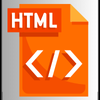HTML stands for Hyper Text Markup Language. It’s the standard language used to create and structure content on the web — everything you see on a webpage (text, images, links, buttons, videos, etc.) is organized using HTML.
Let’s break it down clearly 👇
1. What HTML Is
HTML is a markup language, not a programming language.
That means it uses tags to mark up pieces of content and describe their role in a webpage.
Example:
<p>This is a paragraph.</p>
Here:
<p>is an opening tag</p>is a closing tagThis is a paragraph.is the content
Together, this tells the browser: “Display this as a paragraph.”
2. How HTML Works
When you visit a website:
- Your browser (like Chrome or Safari) downloads an HTML file from a web server.
- The browser reads the HTML line by line.
- It uses the tags to understand:
- what content to show,
- how it’s structured,
- and how it connects to other files (like CSS or JavaScript).
Example of a basic webpage:
<!DOCTYPE html>
<html>
<head>
<title>My First Page</title>
</head>
<body>
<h1>Hello, world!</h1>
<p>Welcome to my first HTML page.</p>
<a href="https://www.google.com">Go to Google</a>
</body>
</html>
<html>→ the root of the page<head>→ contains info about the page (not shown directly)<body>→ contains what the user sees<h1>,<p>,<a>→ different elements (heading, paragraph, link)
3. HTML + CSS + JavaScript
HTML by itself defines structure only.
For a complete webpage:
- HTML → structure and content
- CSS (Cascading Style Sheets) → style and design (colors, fonts, layout)
- JavaScript → behavior and interactivity
Together, they form the core of web development.
Example Visualization
Think of a webpage like a house:
- HTML → the structure (walls, rooms)
- CSS → the paint and decor
- JavaScript → the lights and moving parts
Next:
Structure of an HTML document.
FAQ Section:
1. What is HTML?
Answer:
HTML (HyperText Markup Language) is the standard language used to create and design web pages. It defines the structure and layout of a webpage using a set of elements and tags.
2. What is the difference between HTML and CSS?
Answer:
HTML is used to structure the content of a webpage, while CSS (Cascading Style Sheets) is used to style and format that content — such as colors, fonts, and layout.
3. What are HTML tags and elements?
Answer:
An HTML tag is the markup enclosed in angle brackets (e.g., <p>). An element includes the opening tag, content, and closing tag — for example:
<p>This is a paragraph.</p>
4. What is the purpose of the <head> and <body> tags?
Answer:
- The
<head>tag contains meta information, the title, styles, and links to scripts or external resources. - The
<body>tag contains the visible content of the webpage (text, images, links, etc.).
5. What is the difference between block-level and inline elements?
Answer:
- Block-level elements (like
<div>,<p>,<h1>) start on a new line and take up the full width. - Inline elements (like
<span>,<a>,<strong>) stay in the same line as surrounding text.
6. What are semantic HTML elements?
Answer:
Semantic elements clearly describe their meaning to both the browser and developer, such as <header>, <footer>, <article>, and <section> — improving readability and SEO.
7. What is the difference between <div> and <span>?
Answer:
<div>is a block-level container used for grouping sections of content.<span>is an inline container used for styling parts of text or small content pieces.
8. What are attributes in HTML?
Answer:
Attributes provide additional information about an element, written inside the opening tag.
Example:
<img src="image.jpg" alt="A beautiful scene">
Here, src and alt are attributes.
9. What is the <!DOCTYPE html> declaration for?
Answer:
It defines the document type and HTML version — telling browsers to render the page in standards-compliant mode. In HTML5, it’s written simply as:
<!DOCTYPE html>
10. What are some common HTML5 features?
Answer:
HTML5 introduced several new features such as:
- New semantic elements (
<header>,<nav>,<section>,<article>,<footer>) - Multimedia support (
<audio>,<video>) - Local storage APIs (
localStorage,sessionStorage) - Canvas and SVG for graphics.
Also Read:
- HTML Projects.
- CSS Projects.
- JavaScript Projects.
Other Courses:



